What Is Best Humidity Level for Paper and Watercolor Art
Markers: a ownership guide
In this guide to buying markers, I'll explain everything you demand to know so that you tin confidently purchase the markers that will work best for your creative needs! I'll cover things like tip shape, blending, brands, costs and the important differences between water-based and alcohol-based markers. I'll finish up with my recommendations for the best markers you can buy.
Since 2014 I've published 23 coloring books (selling over iii.v meg copies) and as a result, I've done a lot of a of illustrating and experimenting with markers - amassing a collection of 600+ markers from over a dozen different brands! You can meet just a fraction of my drove in the picture below. In this Intro to Markers Guide I'll pass on everything I've learned, so read on to observe out which markers will exist all-time for you!

If yous don't accept time to read all this and you just want to meet my recommendations, you tin can bound straight to The All-time Markers for fine art and illustration.
A quick overview
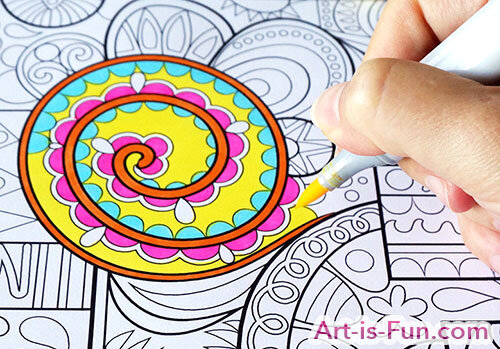
Not that long ago, markers were traditionally a niche tool used primarily by graphic designers and manga artists. Because markers are not as fade-resistant as other media, they were avoided by serious artists who had longevity in mind. Only over time, as artists began to make art for the internet, more than and more artists became attracted to the fantastic versatility of markers and their wide range of vivid colors.
Markers are affordable, user-friendly, don't make a mess, work well with other media and allow y'all to apply bold colour chop-chop and easily! What's not to love?!

All kinds of artists have found a use for markers. Because they're like shooting fish in a barrel to use and dry speedily, markers are dandy on-location or outdoors - perfect for travel, plein-air studies or urban sketching. Their effortless application of color makes markers well-suited to doodling, sketching and gesture-drawing. Markers can also blend smoothly, making them capable of photorealism, abstraction, and everything in between!
Markers have also experienced a huge surge in interest these past few years thanks to the adult coloring trend. Colorists love the wide range of color choice and the convenience of unlike tip shapes. This demand has triggered an explosion in the number of marker products on the market. This affluence of choice means that there'southward a marker out at that place for every artist and price bespeak. The hardest part is wading through all the different options to figure out which suits you lot best, only I'm here to assist yous with that!

Tip Shapes
Before we dive securely into the different brands, you lot'll first need to decide what blazon of tip shape or nib you desire, because the tip shape greatly impacts your feel of coloring. Here'south an overview of your options. Note that these terms are non standard across brands - for example, some manufacturers will utilize the phrase "fine tip" to refer to a tip that's more similar to a bullet tip.
Brush Tip
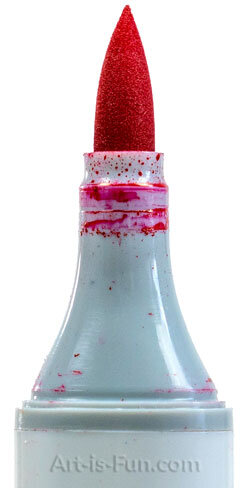
Castor tips (aka "brush pens") are my accented favorite considering they're the virtually versatile. The point can be used to create thin strokes (perfect for detailed work) and the brush tin as well be flattened to make full in large areas. You tin also use the brush tip to create variable-width strokes. Brush pens are typically more expensive than other types, but for some brands the tips can be replaced when they become worn.
Chisel Tip

The chisel tip is very common across brands. Information technology'south useful considering you can utilise different edges for different purposes. The wide, apartment side is great for laying down lots of colour, while the pointy side is skillful for thinner strokes (but non equally thin or precise as you can achieve with brush or fine tip markers). To be honest I rarely utilize the chisel tips on my markers, simply that'south simply me - your needs and style may be dissimilar!
Fine Tip
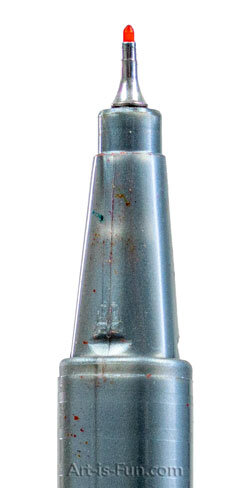
This is merely like what you'd detect on a technical pen that architects utilize. These tips are fantastic for fine details and patterning, but very impractical for larger blocks of colour.
Bullet Tip

The trusty bullet tip is common in lots of cheaper marker sets. It's a good generalist tip, but isn't very versatile, in that super-fine details can exist catchy and filling in large areas with color can be tiresome and tedious.
Double-Concluded Markers

Double-concluded markers are a perfect way to enjoy the best of both worlds! They characteristic a primal ink reservoir with tips on either finish. It's common for high quality alcohol-based markers to be double-ended, near commonly with a brush tip and chisel tip at either end, although some accept a bullet tip (instead of a castor tip) with a chisel tip at the other stop.
Stroke Examples
Equally you can encounter in the image beneath, you can achieve a diversity of strokes with any marker tip, which is pretty cool! Withal, each tip type has its strengths and weaknesses, so the best mark tip for y'all ultimately boils downwards to personal preference and the type of fine art you wish to create.
I ofttimes use the Copic marker brush tip to create unabridged artworks, but the cool thing well-nigh markers is that they can be combined, so you don't need to exercise an entire artwork with the aforementioned tip or brand. Mix and match equally you run into fit. For example, you lot tin can lay down large blocks of colour with a brush tip or chisel tip, and then add together details on acme with a fine or bullet tip!
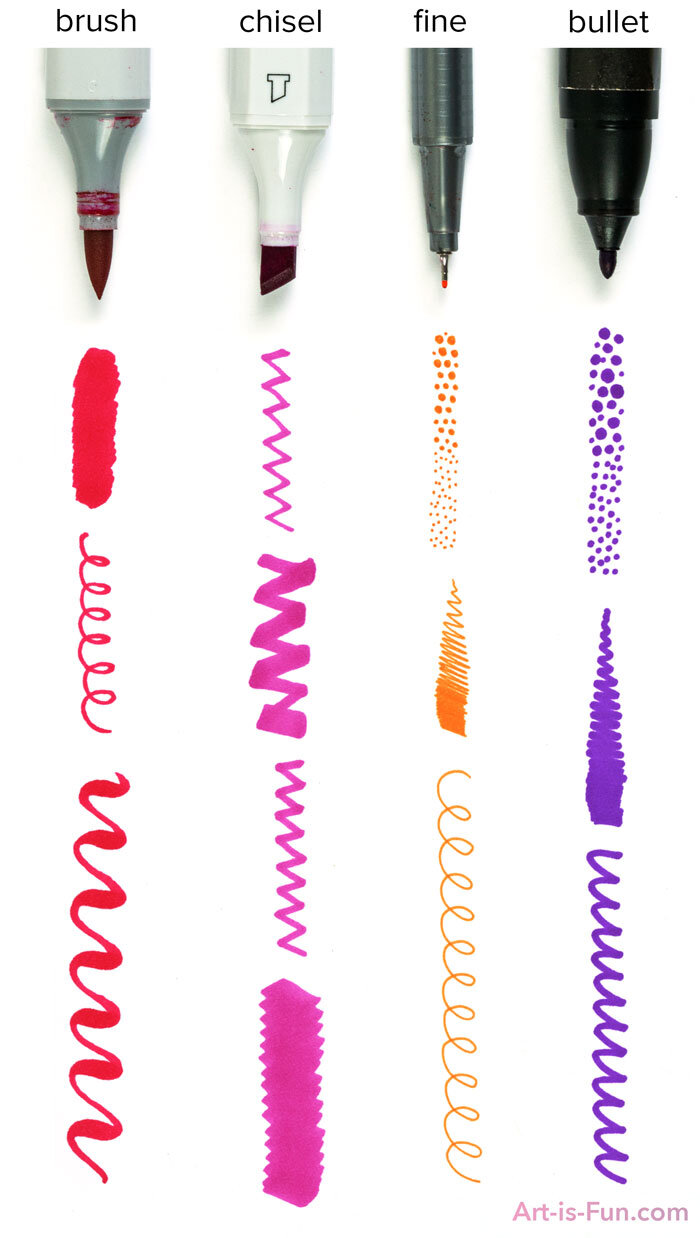
Water-based markers vs. Alcohol-based markers
The next biggest choice you lot'll have to make is whether you want to buy water-based markers or alcohol-based markers.
Markers contain dyes that are suspended in either water or alcohol, which dries and leaves the color behind. This difference - whether the dye is suspended in water versus alcohol - can touch on everything from cost to blend-ability and permanence. Here'southward a quick rundown of how the two types differ:
Water-based markers
-
Cheaper
-
Fewer colors
-
Usually disposable
-
Poor fade resistance
-
Dries less quickly
-
No odor
-
Widely available
-
Tin can warp paper
-
Can be re-activated with water, creating washes.
Alcohol-based markers
-
More expensive
-
More colors
-
Some are refillable
-
Amend fade resistance (just not lightfast)
-
Dries rapidly
-
Can take an odor
-
Found mostly in art supply stores
-
Can drain through newspaper
-
Has transparency, so colors can be layered.
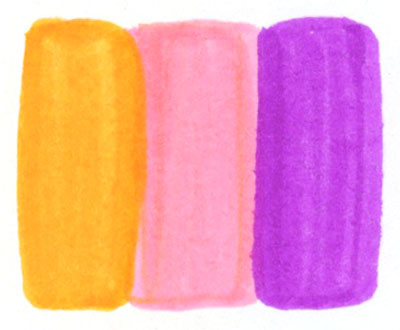
Calorie-free streaking from a water-based mark
Remember using Crayola markers when you were a kid? If so, and then you're already familiar with water-based markers. Water-based markers are widely bachelor in inexpensive, student-class sets designed for kids, fabricated from lower-quality dyes designed to exist easily washable from hands.
Still, water-based markers aren't merely for kids - there'due south a whole range of water-based markers out in that location that are specifically made for professional artists and gorging hobbyists, which can brand them just as good every bit booze-based markers, depending on your intended purpose. Artist-quality markers of both types (water-based and alcohol-based) volition typically contain higher-quality dyes than their cheaper counterparts.
So which are amend: water-based or booze-based markers?
Once yous decide to take the jump from Crayolas to artist-grade markers, it can be difficult to decide between water-based and booze-based markers, so I advise that yous might want to do what I did when I outset started using creative person-quality markers, and try them both. Every bit helpful equally it can exist to read about markers online, it's important to endeavor them yourself to get a firsthand understanding of how they work, which which will aid you decide which ones you prefer using. Thankfully both types of markers are available open stock (singles) or in small sets, so you can attempt some out without breaking the bank!
Hither's a little summary between these ii options:
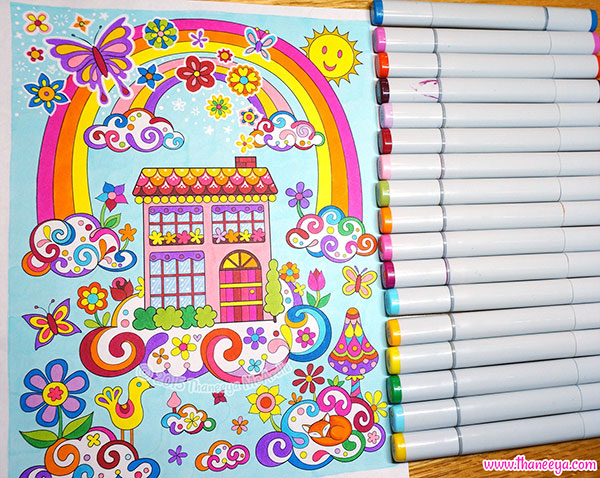
Water-based markers are available everywhere, virtually usually in those cheap sets designed for children, but you tin also buy artist-quality h2o-based markers that are amazingly versatile. Because water-based markers don't drain through the paper as much, they're well-suited for use in coloring books. The major downside is that if you lay down likewise much color, they tin warp or harm the paper. H2o-based markers are likewise extremely popular for manus-lettering.
Alcohol-based markers (sometimes called "permanent markers") are typically the preferred choice of artists because they blend more smoothly and predictably (see beneath), and yous can create shades, tints and ombrés by overlaying colors. They do tend to drain through the paper, and then double-sided coloring books are not ideal. For more info, check out Tips for Using Alcohol Markers in Coloring Books.
The image beneath is a comparing of how well h2o-based and alcohol-based markers lay down color. These are relatively large iii-inch circles on cardstock. As yous can see, water-based markers can exist streaky when the colors are overlapped to create a solid fill. While booze markers don't announced as streaky, they can have some variations in saturation, with some areas appearing slightly lighter or darker than others. Whether y'all honey or loathe these attributes depends on your personal style - for example, some people (like me) capeesh the subtle variations in alcohol markers because it lends the artwork a more natural, organic experience, whereas I become frustrated past the streakiness of water-based markers when trying to make full large spaces.
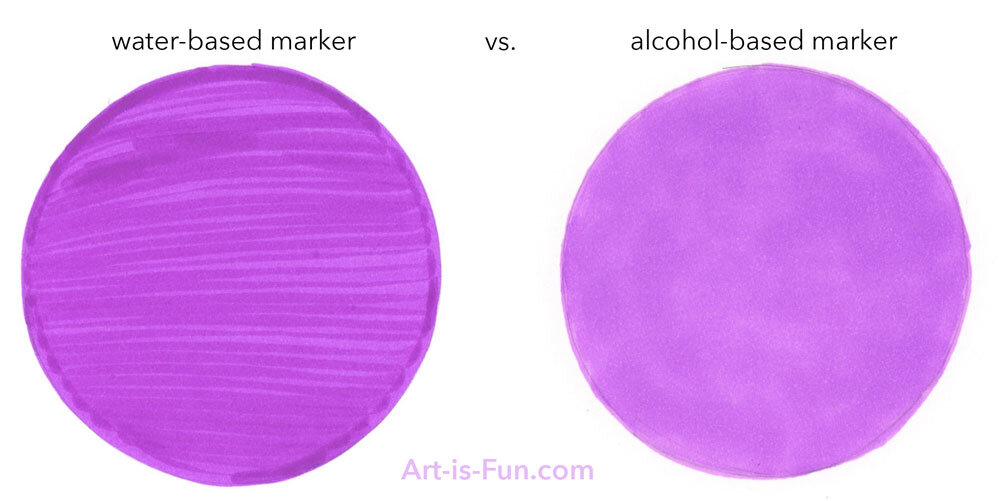
A comparison of how well water-based and alcohol-based markers lay down colour on cardstock.
If you're in a shop and thinking of buying some markers but can't figure out if they're water- or alcohol-based, popular off the lid and gently aroma (some can be pungent, then be cautious). If there's a strong olfactory property, they are alcohol-based markers.
Color Range
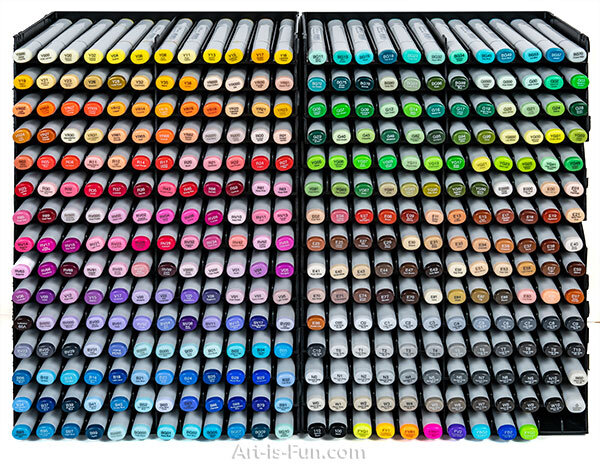
Color range is of import considering it helps yous achieve better tonal gradation with your blending. This is considering yous're able to apply a range of like tones to blend one color into another, creating a squeamish smoothen transition.
Alcohol-based markers offer the widest color range, and can frequently exist purchased open up stock (one at a time). Here'due south my collection of the full range of Copic Sketch Markers, consisting of 358 colors! To exist honest, yet, I almost never need that many colors, so don't feel like you admittedly need to get them all to make peachy art.
After you've bought markers, it'southward a good idea to create a color chart to use as a reference. Hither's a template that the company Copic created for their markers. I use this as a handy reference whenever I'one thousand making fine art with my Copics. Here's my completed version:
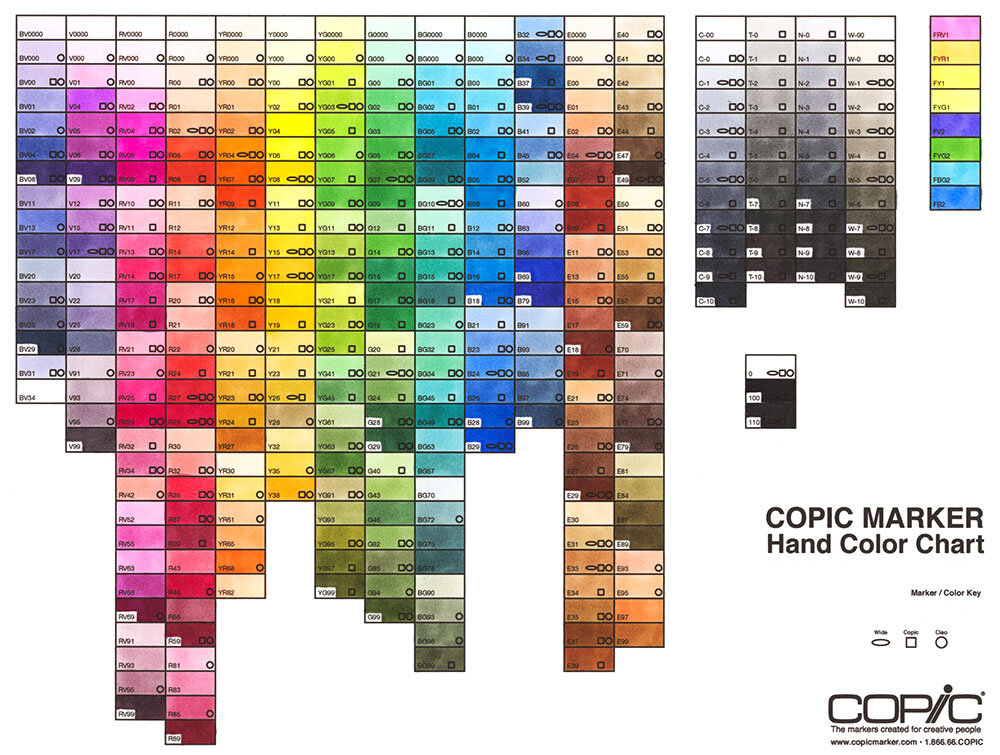
If you'd like to learn more than about Copics, including the unlike products they offer, check out my all-encompassing review of Copic Markers.
Blending
When making fine art, the ability to create smooth blends can make an artwork really come to life. The result tin await so stunning and professional person that yous wouldn't even recollect it was fabricated with markers!
Here's an example from my Holiday Cheer Coloring Volume that I colored with Copic Sketch Markers. I employed blending in just well-nigh every element, especially to bring out the highlight on the hat!
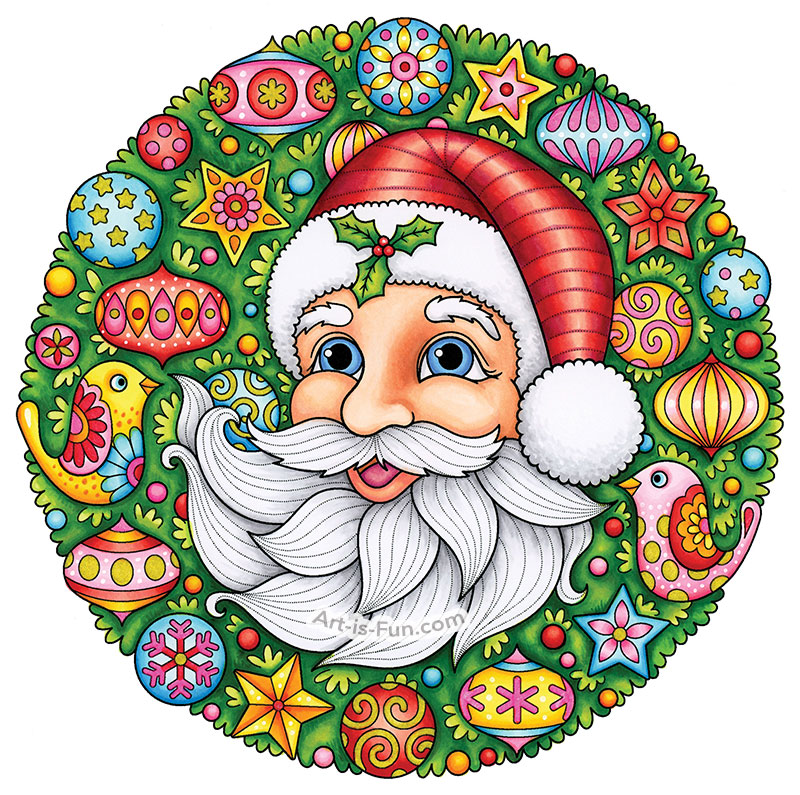
Both water-based and alcohol-based markers are capable of blending, but each has its ups and downs. Annotation that blending performance is heavily reliant on the paper you lot're using. For instance, I've found that alcohol-based markers blend fantastically on marking newspaper, but when I tested them on heavyweight multimedia paper it was difficult because the paper was too absorbent. I'one thousand currently developing a separate commodity to test a range of markers on unlike types of newspaper - stay tuned!
Blending with water-based markers
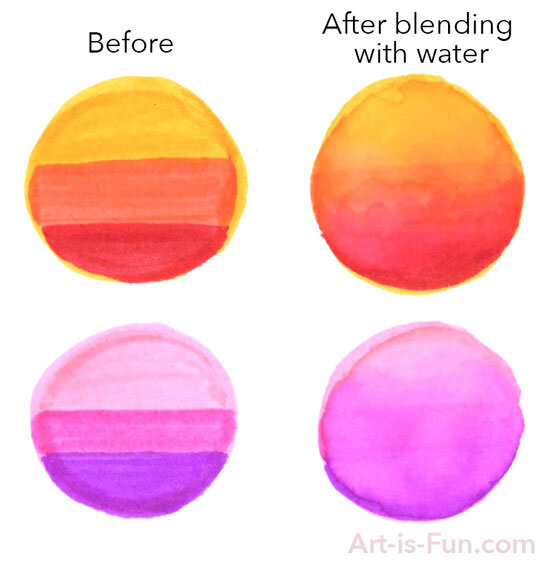
-
H2o-based markers tin can get out streaks when you're blending, and create unwanted darker areas when yous accidentally layer strokes.
-
Excessive blending can can too warp or damage paper, which is why you should utilise watercolor paper (considering it's tough) or marking paper, which is less absorbent, thereby allowing you more time to blend. (That said, water-based markers can tear or pill just virtually whatever type of paper, including watercolor paper and marker paper, depending on your technique.)
-
Water-based markers tin be re-activated after they've dried, which allows you to lighten them with water or create washes (just the downside is y'all might accidentally ruin an expanse you lot'd already finished by getting it wet).
-
Blending with water-based markers can exist more unpredictable than blending with alcohol markers because water can react with the dye in unexpected ways that can be difficult to control. While some may find this frustrating, it's a trait that many watercolorists capeesh, so if yous've got experience with watercolor pigment, your skills will transfer well to blending with water-based markers.
-
You lot tin can as well dip the tip of your marking in water to create a polish transition in tone and saturation (from light to night).

Creating washes with h2o-based markers
Blending with alcohol-based markers
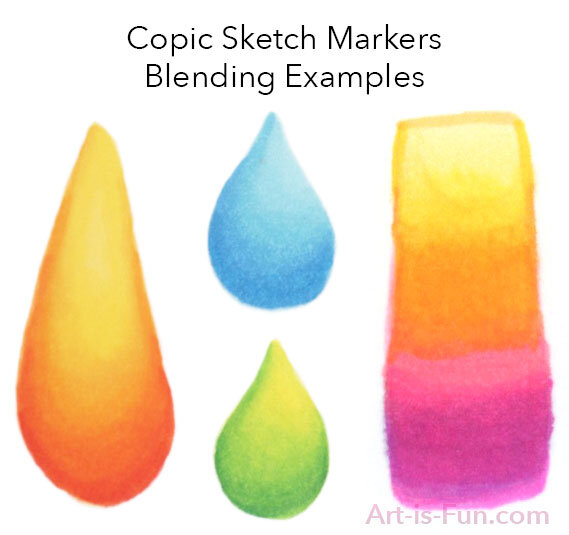
-
Booze-based markers, on the other mitt, blend more smoothly, just because they dry very quickly, you lot have to move fast. And one time they're dry, that's it - the colors are very difficult to remove and whatever additional blending will darken or alter the existing colors. These qualities can make information technology difficult to smoothly comprehend large areas with alcohol-based markers or create large gradients (but it's perfect for smaller areas).
-
Because alcohol markers are partially transparent, yous can layer colors on top of one some other to create different shades or tints.
-
Blending with alcohol markers is more predictable than blending with water-based markers, in that you know how the colors volition interact then it'southward pretty easy to replicate previous blends.
-
I downside with alcohol markers is that they can bleed through the paper. For this reason, I similar to use my Copics on thick cardstock or marking paper. Simply if y'all're planning to use them in coloring books (almost of which accept thin newspaper) y'all should put some scrap paper backside the page y'all're coloring (or gently tear the page out and so color it on top of chip paper) and so that the dye can't stain other pages.
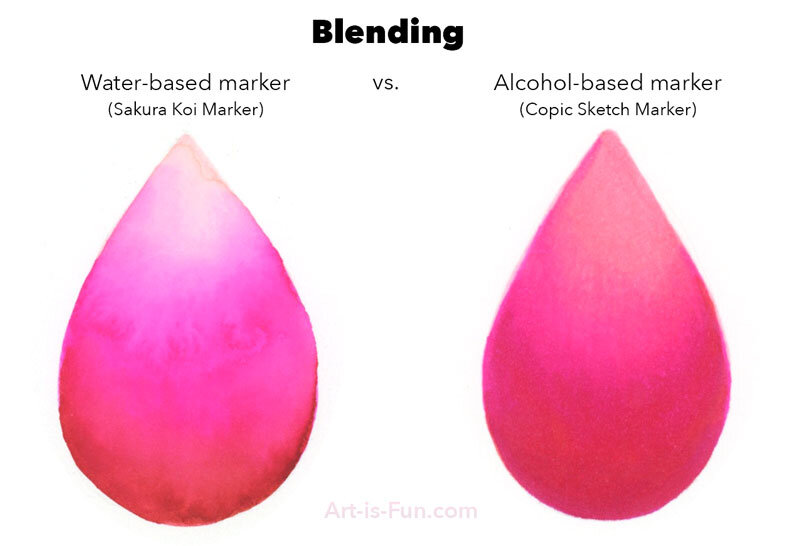
A fantastic characteristic of all markers is that you can mix different mark types and brands, and fifty-fifty combine them with other media similar colored pencils. If I'grand not happy with how I've blended some colors or I've got some streaking, I get over the area with Prismacolor Colored Pencils to smooth out those imperfections.
In the paradigm below (a section of 1 of my coloring pages), I used Copic Sketch Markers for well-nigh of the work, but then used Prismacolors to ameliorate the shading and details on her confront and hair.
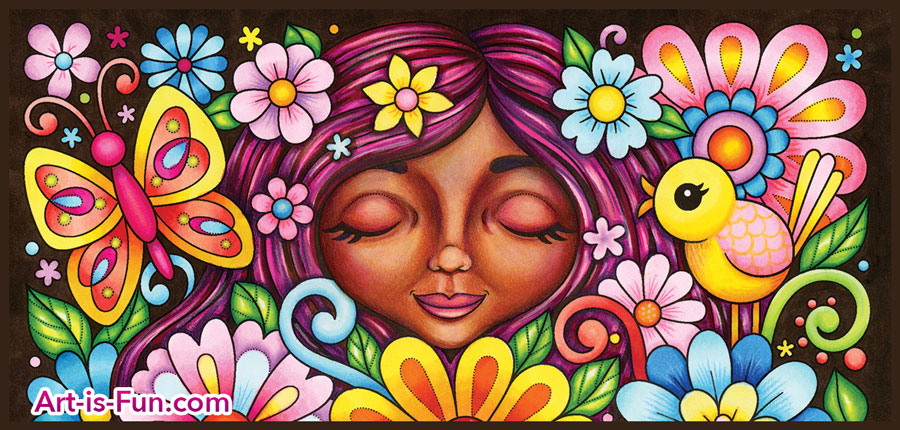
Using Prismacolor Colored Pencils with markers
Some marking brands come up with blenders, which are basically markers filled with solvent and no dye, so they're "clear" and colorless. Despite the name, these tools aren't really used for blending. Rather, they're good for lightening areas of your artwork and adding highlights. They're likewise useful for fixing mistakes and blending from colour to white. Copic's Colorless Blender can be used with alcohol-based markers and Tombow's N00 Colorless Blender Pen can be used with water-based markers. I have both only I personally don't use them much.

Copic and Tombow Colorless Blenders
If you're interested in learning more than about blending, cheque out this Skillshare course: Blending with Water Based Markers, available with their 14-day free trial (if you sign upwards I get a commission that helps support this site).
Tip: if the nib becomes muddy, just scribble on a blank scrap of paper until information technology's make clean. This works for both water-based and alcohol-based markers!
Lightfastness
All art media will fade over time equally light, oxygen and humidity gradually break the chemical bonds of the molecules that produce the color. The power to resist color fading is chosen lightfastness. If yous're creating artworks that you lot hope to preserve, it's a good idea to discover media classified as lightfast or archival, which tin hold their color for decades. But beware, you lot tin can't ever trust these labels.
As I've already mentioned, markers get their color from dye, which is more than susceptible to fading than the pigments you lot'd observe in paint, pastels or pencils. For this reason, the vast majority of markers are not truly lightfast (for example, "permanent" markers will also fade).

If you make a purchase via the Blick links below I receive a minor committee, at no extra cost to you.
If you're especially concerned about lightfastness, merely still want the convenience of markers, check out Winsor and Newton's Pigment Markers and Watercolor Markers, both of which contain pigment rather than dye. You lot could likewise consider Faber-Castell'south Pitt Artist Pens, which contain pigmented India ink that is more fade resistant than dye (but unlike other water-based markers, these pens are permanent and waterproof afterwards they're dry).
Bottom line: your marker art volition fade more apace than other media. To illustrate, here's an example of an artwork I created 2.five years ago using Copic Sketch Markers. The second image is after information technology spent 2.5 years on my refrigerator, existence exposed to daily indirect light.

Annotation how much my markers faded over the grade of ii.5 years on my refrigerator. Most colors look surprisingly skillful only that dark purple background really faded!
There are some steps you can take to dull color fading:
- Prioritize alcohol-based markers because they incorporate better quality dyes and are more lightfast.
- Store your marker art away from direct sunlight or framed under UV-filtering glass. I store my marker art in archival boxes, and even after a few years, at that place'due south very little fading.
- You lot can also treat the finished artwork with a production like Golden Archival Spray Varnish, but you lot must test it first because it can easily ruin an artwork. It's important to await several hours for the markers to set, because if you spray it as well soon, the spray varnish tin cause the colors to run. Information technology tin can also darken your artwork or add together a particular sheen that changes the look, so it'due south best to test it out on some marker doodles to see what happens.
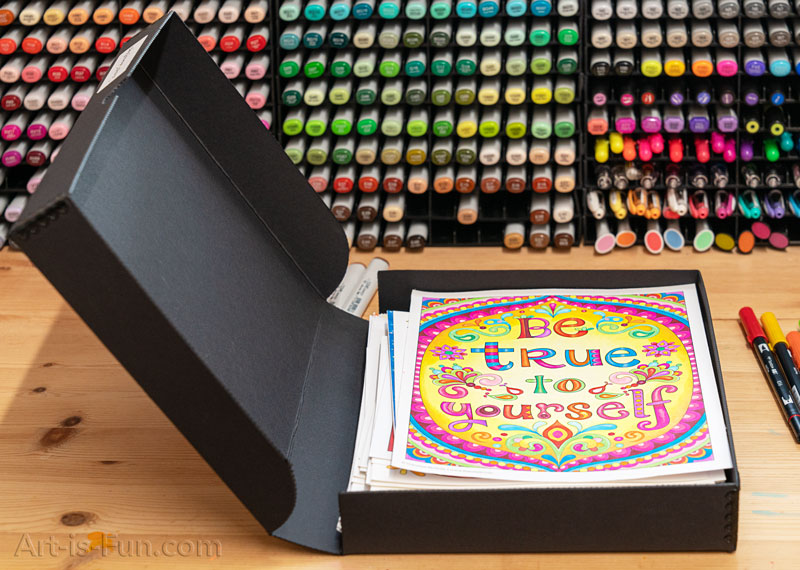
I protect my coloring pages in an archival box
Whether lightfastness is an issue for you depends on your workflow. These days, I create almost all of my art for the purpose of licensing and publishing rather than selling originals. Every bit shortly equally I've finished a piece, I scan it at 600 DPI and then it's preserved in my digital fill-in system. If you're planning on displaying your work, you tin create prints from your digital scans and it will expect so similar to the original that no ane will inappreciably know the difference (just exist certain to market them as prints if you intend to sell them or display them publicly)!
Toll
Alcohol markers are typically more expensive than water-based markers. But for the price bump y'all get better quality dyes, smoother blending, more than colors, and the price-saving power to refill your markers and replace damaged tips.
I'm not going to listing prices here considering they tin vary widely from the list price, with Blick often offering steep discounts that tin can fluctuate. In general you can go Sharpies for about a dollar a slice or less, but for creative person-quality alcohol markers, expect to pay between $3 to $7 per marker (less if you get a set).
Most water-based markers, on the other hand, cannot be refilled and the marking has to be thrown abroad when information technology runs dry or the tip becomes damaged. Only if you're on a budget, yous can still pick up some artist quality markers for betwixt $2 to $5 each.
The Best Markers
I've provided links beneath to the relevant products and then that you can hands find them on Blick Art Materials, my favorite art supplier. If yous make a purchase afterwards clicking on 1 of these links, I'll receive a pocket-sized commission (at no extra cost to you). Read my disclosure statement to learn more than.
When buying art supplies I prefer to shop from Blick because you know y'all'll go accurate products from respected art brands. Ownership from Amazon can sometimes be a mixed bag because many products are sold by third-party sellers who might sell false products of questionable quality or even counterfeit products bearded equally proper noun brands. Thankfully that's never a problem when buying from an established art supplier like Blick!
The Best Alcohol-Based Markers
My overall option are the Copic Sketch Markers. As I mentioned, I accept the complete set of 358 colors and I have been using them to create colored art for my books since 2014. Although they're amongst the most expensive markers you can purchase, you can refill them and modify out the nibs, and then they'll last a lifetime.
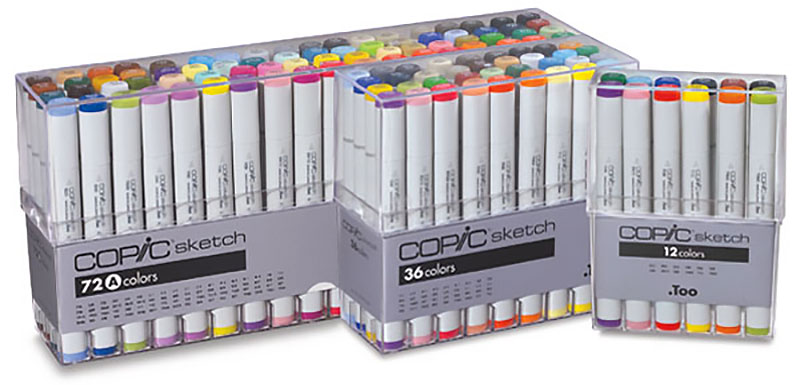
Yous can often save money by buying them in sets. I acquired all 358 colors gradually over the form of 1-ii years - there'due south no need to rush and buy all of them at one time (unless you can beget it and desire to). I similar that Copic Sketch Markers are double-ended, with the brush tip on i end and the chisel on the other. Read higher up to learn about how well they perform when it comes to coloring and blending. To acquire more than, bank check out my extensive review of Copic Markers.
My budget pick for professional-quality alcohol markers are the Blick Studio Brush Markers. They're very similar to Copics (they're refillable and the brush and chisel nibs can be replaced), but cost $iii less per mark than the Copic Sketch! I've tested them myself, and it'south honestly hard to tell the difference! They tin't compete with Copic Sketch's color range, just yous still get 143 colors plus a colorless blender – more than enough.
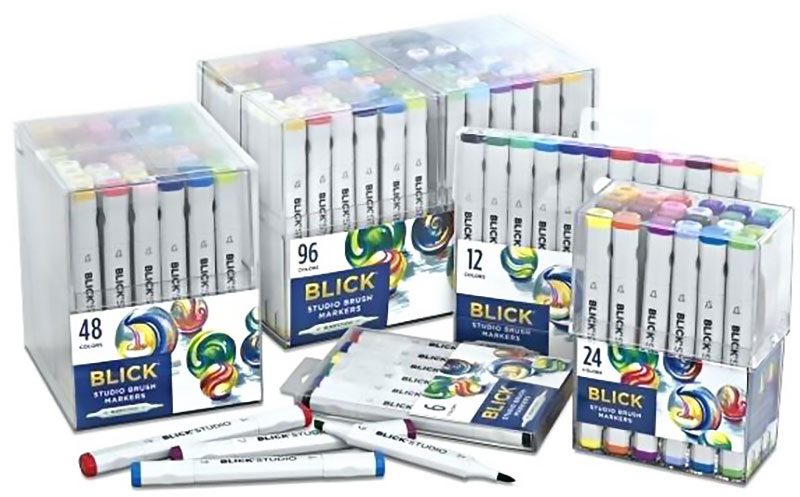
For those of you on a tight budget who are keen to try out alcohol markers, Ohuhu booze brush markers (shown beneath) are my ultra-budget selection. They're fifty-fifty cheaper than Blick Studio Markers but I would hesitate to call them "professional person-quality" because (at the time of this writing) they're not refillable, the nibs aren't replaceable (and tend to fray much more quickly than the pro-level markers) and they're but available in sets (whereas Blick and Copic Markers are available individually). However, for beginners and hobbyists looking for an introduction to alcohol markers, they're a great buy! Plus, Ohuhu is considering offer refills and selling their markers individually, so they are certainly a company to watch if those factors are important to you. Read my in-depth review of Ohuhu alcohol brush markers to find out if they're right for you!

Another first-class ultra-budget pick are Arrtx Markers (shown below), which are a good choice if you adopt the bullet/fine tip over the brush tip that comes with the other products mentioned in a higher place. Like the Ohuhu markers, they aren't refillable and the tips aren't replaceable, but they come up with a handy carrying case with an individual slot for each marker. Read my detailed review of Arrtx Markers to learn more than!

The Prismacolor Premier Double-Concluded Art Markers accept a lot going for them: reliable brand, huge range of colors (200 + blender), they're available in open stock, and they toll less than the Copics. However, they're non refillable and the nibs can't exist changed out. They're double-ended, just merely with the chisel & bullet or fine tips (no brush tips). I strongly favor the brush tip, but if you don't, these should exist high on your list.
The Best H2o-Based Markers
My overall pick are the Zig Art & Graphic Twin Markers. They're double-ended (brush and fine bullet tips) and offer an impressive eighty colors. The nibs can't exist inverse out and they're not refillable, only they're adequately inexpensive for being artist-quality (around $three per marker) and even less if y'all buy a set.
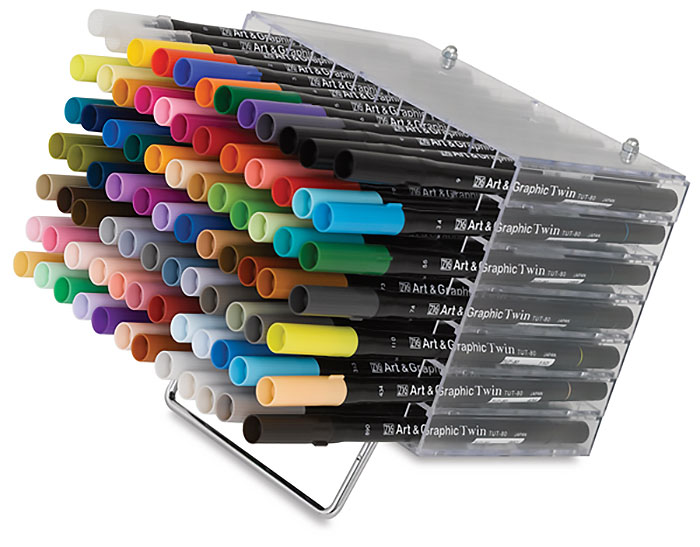
The product beneath is available on Amazon. As an Amazon Associate I earn from qualifying purchases.
My upkeep selection are the Akashiya Sai Watercolor Castor Pens. I don't know much well-nigh the brand and they only take a color range of 30, but I merely had to recommend them because they've been a joy to use and they're inexpensive. I got the gear up of 20 because they were on sale, and I immediately loved the flexibility and smoothness of their brush tip. The color glides off the pecker and their blending capabilities are amazing for the cost. Every bit I write, the 20-colour set is effectually $20-thirty and the 30-color gear up is $l.
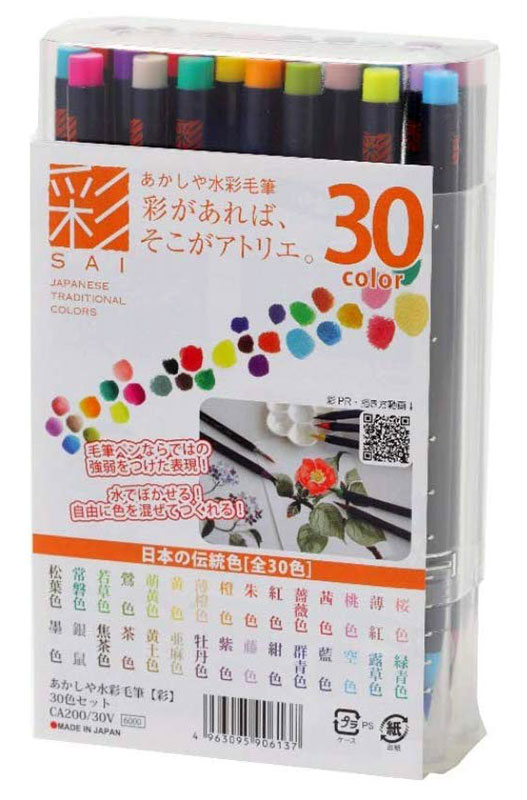
I also recommend the Sakura Koi Coloring Castor Pens, but they lost out to the Zig markers considering they offer fewer colors (48 vs 80). I besides like the Tombow Dual Brush pens, but despite their superior colour range (108 colors), they lost out considering they didn't seem to alloy as well and the brush tip was a bit stiff and as a event, tore about every paper I tried to blend them on. The Faber-Castell Pitt Artist Pens come up from a reliable brand, and incorporate pigmented India ink (which is more lightfast), but I constitute that they didn't blend also as I would accept liked. I can encounter why they're popular with people who like manus-lettering though.
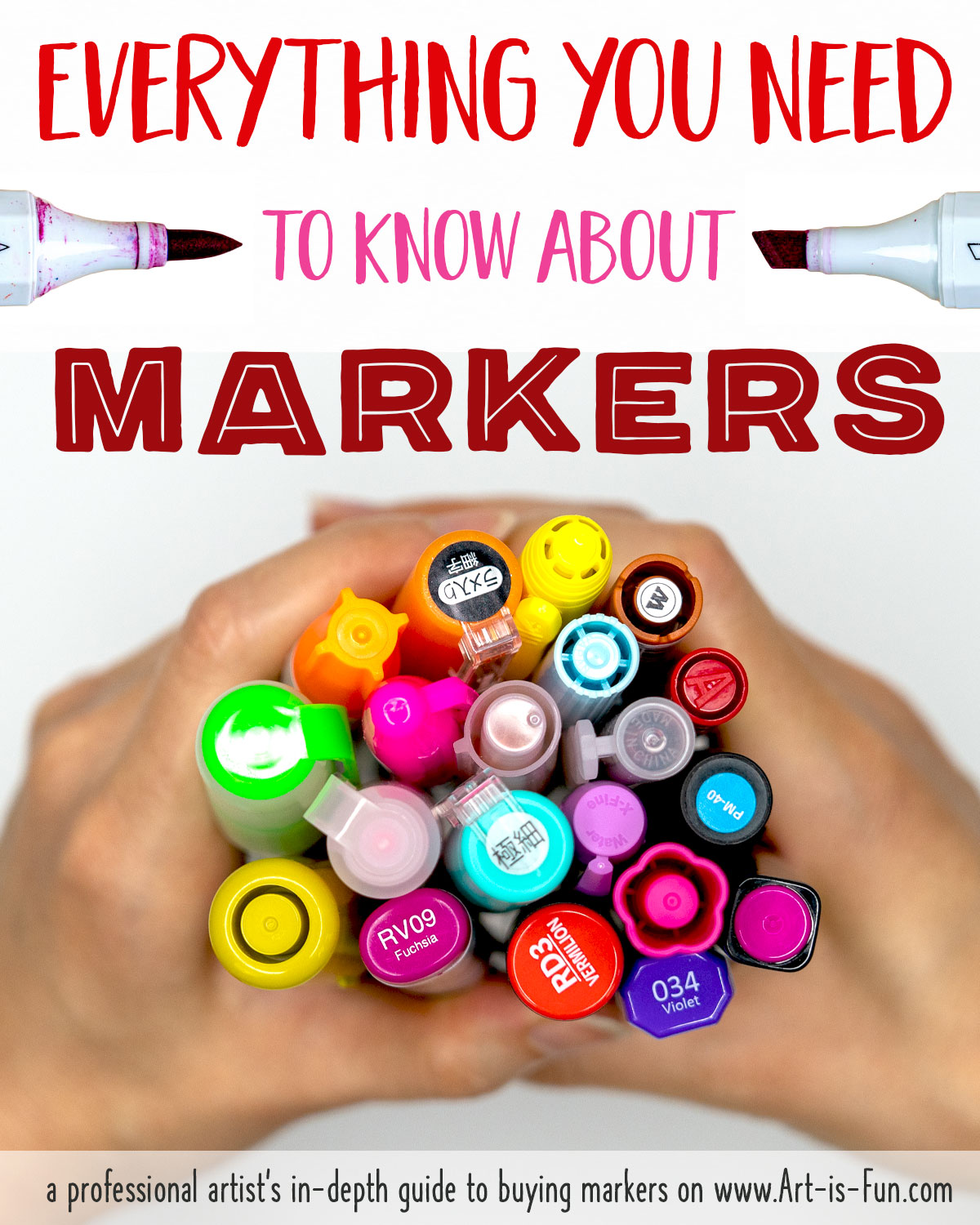
Source: https://www.art-is-fun.com/markers
0 Response to "What Is Best Humidity Level for Paper and Watercolor Art"
Postar um comentário